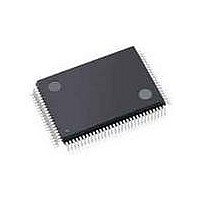C8051F040-TB Silicon Laboratories Inc, C8051F040-TB Datasheet - Page 54

C8051F040-TB
Manufacturer Part Number
C8051F040-TB
Description
BOARD PROTOTYPING W/C8051F040
Manufacturer
Silicon Laboratories Inc
Type
MCUr
Specifications of C8051F040-TB
Contents
Board
Processor To Be Evaluated
C8051F04x
Interface Type
USB
Lead Free Status / RoHS Status
Contains lead / RoHS non-compliant
For Use With/related Products
C8051F040
Lead Free Status / Rohs Status
Lead free / RoHS Compliant
- Current page: 54 of 328
- Download datasheet (3Mb)
C8051F040/1/2/3/4/5/6/7
5.3.
ADC0 has a maximum conversion speed of 100 ksps. The ADC0 conversion clock is derived from the sys-
tem clock divided by the value held in the ADC0SC bits of register ADC0CF.
5.3.1. Starting a Conversion
A conversion can be initiated in one of four ways, depending on the programmed states of the ADC0 Start
of Conversion Mode bits (AD0CM1, AD0CM0) in ADC0CN. Conversions may be initiated by the following:
The AD0BUSY bit is set to logic 1 during conversion and restored to logic 0 when conversion is complete.
The falling edge of AD0BUSY triggers an interrupt (when enabled) and sets the AD0INT interrupt flag
(ADC0CN.5). Converted data is available in the ADC0 data word MSB and LSB registers, ADC0H, ADC0L.
Converted data can be either left or right justified in the ADC0H:ADC0L register pair (see example in
Figure 5.7) depending on the programmed state of the AD0LJST bit in the ADC0CN register.
When initiating conversions by writing a ‘1’ to AD0BUSY, the AD0INT bit should be polled to determine
when a conversion has completed (ADC0 interrupts may also be used). The recommended polling proce-
dure is shown below.
5.3.2. Tracking Modes
According to Table 5.2, each ADC0 conversion must be preceded by a minimum tracking time for the con-
verted result to be accurate. The AD0TM bit in register ADC0CN controls the ADC0 track-and-hold mode.
In its default state, the ADC0 input is continuously tracked when a conversion is not in progress. When the
AD0TM bit is logic 1, ADC0 operates in low-power tracking mode. In this mode, each conversion is pre-
ceded by a tracking period of 3 SAR clocks after the start-of-conversion signal. When the CNVSTR0 signal
is used to initiate conversions in low-power tracking mode, ADC0 tracks only when CNVSTR0 is low; con-
version begins on the rising edge of CNVSTR0 (see Figure 5.4). Tracking can also be disabled when the
entire chip is in low power standby or sleep modes. Low-power tracking mode is also useful when AMUX
or PGA settings are frequently changed, to ensure that settling time requirements are met (see
“5.3.3. Settling Time Requirements” on page
54
ADC Modes of Operation
• Writing a ‘1’ to the AD0BUSY bit of ADC0CN;
• A Timer 3 overflow (i.e., timed continuous conversions);
• A rising edge detected on the external ADC convert start signal, CNVSTR0;
• A Timer 2 overflow (i.e., timed continuous conversions).
Step 1. Write a ‘0’ to AD0INT;
Step 2. Write a ‘1’ to AD0BUSY;
Step 3. Poll AD0INT for ‘1’;
Step 4. Process ADC0 data.
56).
Rev. 1.5
Section
Related parts for C8051F040-TB
Image
Part Number
Description
Manufacturer
Datasheet
Request
R
Part Number:
Description:
SMD/C°/SINGLE-ENDED OUTPUT SILICON OSCILLATOR
Manufacturer:
Silicon Laboratories Inc
Part Number:
Description:
Manufacturer:
Silicon Laboratories Inc
Datasheet:
Part Number:
Description:
N/A N/A/SI4010 AES KEYFOB DEMO WITH LCD RX
Manufacturer:
Silicon Laboratories Inc
Datasheet:
Part Number:
Description:
N/A N/A/SI4010 SIMPLIFIED KEY FOB DEMO WITH LED RX
Manufacturer:
Silicon Laboratories Inc
Datasheet:
Part Number:
Description:
N/A/-40 TO 85 OC/EZLINK MODULE; F930/4432 HIGH BAND (REV E/B1)
Manufacturer:
Silicon Laboratories Inc
Part Number:
Description:
EZLink Module; F930/4432 Low Band (rev e/B1)
Manufacturer:
Silicon Laboratories Inc
Part Number:
Description:
I°/4460 10 DBM RADIO TEST CARD 434 MHZ
Manufacturer:
Silicon Laboratories Inc
Part Number:
Description:
I°/4461 14 DBM RADIO TEST CARD 868 MHZ
Manufacturer:
Silicon Laboratories Inc
Part Number:
Description:
I°/4463 20 DBM RFSWITCH RADIO TEST CARD 460 MHZ
Manufacturer:
Silicon Laboratories Inc
Part Number:
Description:
I°/4463 20 DBM RADIO TEST CARD 868 MHZ
Manufacturer:
Silicon Laboratories Inc
Part Number:
Description:
I°/4463 27 DBM RADIO TEST CARD 868 MHZ
Manufacturer:
Silicon Laboratories Inc
Part Number:
Description:
I°/4463 SKYWORKS 30 DBM RADIO TEST CARD 915 MHZ
Manufacturer:
Silicon Laboratories Inc
Part Number:
Description:
N/A N/A/-40 TO 85 OC/4463 RFMD 30 DBM RADIO TEST CARD 915 MHZ
Manufacturer:
Silicon Laboratories Inc
Part Number:
Description:
I°/4463 20 DBM RADIO TEST CARD 169 MHZ
Manufacturer:
Silicon Laboratories Inc










